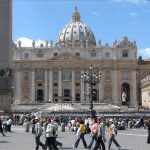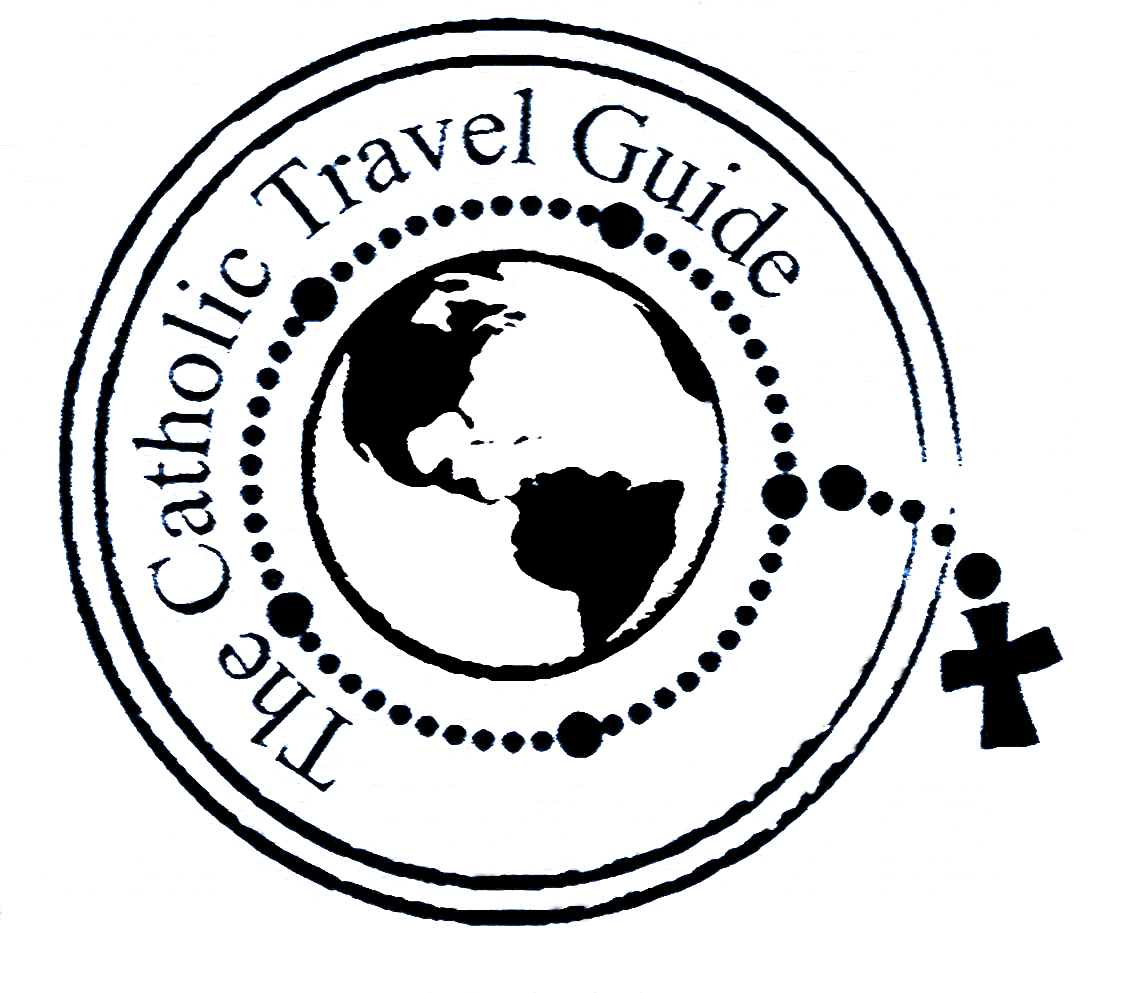Rome: A Catholic’s Guide to Rome, the “Eternal City”
 What can we say about Rome that has not been said a thousand times before? No where else can you find so many reminders of the history of the Catholic Church and so many beautiful churches and monuments.
What can we say about Rome that has not been said a thousand times before? No where else can you find so many reminders of the history of the Catholic Church and so many beautiful churches and monuments.
And much of Rome is easy to walk. Many of these locations are within 10-20 blocks of one another, so if you pace yourself (perhaps stop for a cup of cappuccino…or a gelato….along the way) you can easily visit many of these places on foot. Of course if you are with an organized tour they will probably provide your own private transportation. Check in advance to find out–especially if you have mobility problems–but don’t let that keep you away. And, of course, may organized tours have some free time which allows you to head off to places not included in that particular tour.
A word of warning about local tour guides in Rome:
Some local guides are excellent and some are very poor. In addition, some can be quite anti-Catholic. Comments such as “these items were stolen from…..and brought to Rome” or the use of the word “legend” rather than “tradition” will give the traveler a biased and in-accurate experience.
And, be aware, that Italy has strict licensing laws concerning guides. A guide might be licensed for Assisi, but not Rome, or vice-versa. If you use an unlicensed guide and he gets stopped by the authorities, your tour might come to an abrupt halt!
Click here to read our suggestions about private tour guides in Rome.
Whether traveling on your own or with a group, we recommend you have a map to orient yourself to the city. Even if you are with a tour group, it is nice to know the layout of the city.
For example, you might find that the hotel you are staying in is just a few blocks from Saint Peter’s Square and you can get out and explore on your own after dinner. The “City Wise” maps are great–waterproof and easy to fold and read.
For help finding your way around, we suggest the “Little Black Book of Rome” It is organized by location rather than alphabetically like so many guide books, so it can help you plan your daily itinerary.
And, of course, Rome can be a starting point for many other cities in Italy. And we recommend traveling by train: Italian trains are fast, clean and take you right to the heart of town. Get train & bus schedules, see fares & buy tickets here
Check out the many day trips from Rome: Florence, Tuscany, Naples & more.
Or perhaps a Pasta-Making Class: Cook, Dine & Drink Wine With A Local Chef
Click here for “Vatican Cookbook Set” by The Pontifical Swiss Guard..buy it for yourself or order the gift set for someone else.
Below are some of the most notable Churches in Rome
♦ Indicates one of the Seven Station Pilgrimage Churches of Rome. This is a tradition begun by Saint Philip Neri in the 16th Century & continuing on today.
There are four major Basilicas:
♦ Basilica of St. John Lateran : The Pope’s own church
♦ Basilica of Saint Mary Major: magnificent artwork and home to the statue of Salus Populi Romani
♦ Basilica of St. Paul Outside the Walls: tomb of Paul the Apostle, Pope John XIII and others
♦ Saint Peter’s Basilica: World’s largest church, tomb of Saint Peter
Some other interesting churches:
Basilica of Saint John of the Florentines (San Giovanni dei Fiorentini): tomb of Borromini, relic of St. Mary Magdeline
Basilica di Sant’Andrea delle Fratte: Conversion of Alphonse Ratisbonne, founder of the Congregation of Our Lady of Sion
Basilica of Sant’Agostino: skull of Saint Monica
Basilica of Saint Agnes Outside the Walls (Sant’ Agnese fuori le Mura): additional relics of Saint Agnes
Basilica of Saint Bartholomew: contains 6 chapels dedicated to the martyrs of the 20th century
Basilica of Saints Celso & GiulianoTraditional Latin Mass (inst of Christ the King Sovereign Priest)
Basilica of San Clemente: (tombs of St. Clement & St. Cyrius)
♦ Basilica of Saint Lawrence Outside the Walls: the tomb of Saint Lawrence
Basilica of Saint Maria sopra Minerva: tomb of Saint Catherine of Siena
Basilica of Saint Sabina (Basilica di Santa Sabina all’Aventino): Mother church of the Dominican Order
Basilica of San Chrisogono one of the original parish churches of Rome, tomb of Blessed Anna Maria Taigi
Basilica of Santa Pudenziana: possibly the earliest church in Rome…Peter stayed there beautifully preserved 5th century mosaic
♦ Basilica of the Holy Cross in Jerusalem Many holy relics
Basilica of Saint Mary in Cosmedin: Skull of St. Valentine and “Mouth of Truth”
Basilica of Santa Maria in Ara Coeli: statue of the Bambino Jesu; relics of Saint Helena
Our Lady of the Conception Capuchin Church: the church of the bones
Church of the Gesu: The Jesuit Church and home of St. Ignatius of Loyola.
Church of Saint Agnes in Agony; Located in Piazza Navona… Contains Skull of St. Agnes
Church of Saint Alphonsus Ligouri: Original image of Our Lady of Perpetual Help
Church of San Francesco a Ripa: cell where St. Francis slept, Bernini’s sculpture over tomb of Blessed Ludovica Albertoni
Church of Santa Maria Monticelli: (tomb of Saint César de Bus)
Church of Santa Maria in Vallicella: Tomb of St. Philip Neri
Church of Saint Mary Magdalene: Tomb of Saint Camillius
Church of the Twelve Holy Apostles (relics of St. Philip & St. James the Younger)
Church of Saint Cecilia in Trastevere
Church of Santa Susanna (Now closed..see St. Patricks Church below)
Church of Saint Paul of Tre Fontane : beheading of Saint Paul
Church of San Marcello al Corso: Miraculous crucifix paraded through Rome to stop the plague
Church of San Salvatore in Onda: Incorrupt body of Saint Vincent Pallotti (founder of the Pallatines)
Churches of the Roman Forum : some of the oldest churches in Rome
Domine Quo Vadis, or The Church of “Lord, Where are You Going?”
Saint Mary of Good Help in Castrense Amphitheater
Saint Peter in Chains: Displaying the chains that held Saint Peter when he was in prison
Sanctuary of the Holy Stairs : the steps Jesus climbed to be condemned in Jerusalem
Sanctuary of John Baptist de La Salle
♦ Sanctuary of Our Lady of Divine Love: Famous Marian Sanctuary and statue
National churches in Rome:
National churches today resulted from an ancient tradition where pilgrims gathered in certain churches in Rome or built churches of their own. These churches aided pilgrims by providing cheap lodging with free or inexpensive food.
Today most countries have a national church in Rome and pilgrims have an opportunity to hear Mass in their native language.
Regardless of your nationality, you should try to include some of them in your visit to Rome. Most have magnificent works of art, perhaps tombs of certain Popes or Saints, or other features that make them worthy of a visit no matter what your country of origin. Some of these churches might also be listed above.
Canada: Our Lady of the Blessed Sacrament and the Canadian Martyrs
France: Church of Saint Louis of the French: magnificent Baroque church with paintings by Carvaggio
Germany: Church of Santa Maria della Anima
Japan: Church of Santa Maria dell’Orto (St. Mary of the Garden)
Netherlands: Church of Michael and Magnus Two major relics: stone where Jesus was presented at the Temple in Jerusalem, which is used as the main altar of the church and the stone where Abraham bound Isaac.
Phillippines: Basilica of Saint Pudenziana
Poland: Church and Hospice of Saint Stanislaus Martyr
Slovakia: Church of San Girolamo della Carita (Saint Jerome of Charity) beautiful artwork; St. Jerome & St. Philp Neri lived here
Spain: Santa Maria in Monserrato degli Spagnoli (Holy Mary of Montserrat)
U.S.A.: American Parish in Rome: Church of Saint Patrick
And other places to visit:
Castel Sant’ Angleo: Where an angel appeared to a Pope and stopped the ravages of the Plague
The Lateran Apostolic Palace: Former Palace of the Pope
Piazza Navona: one of the most interesting Piazzas in Rome & Church of St. Agnes in Agony
San Lorenzo Center for young people
The Museum of the Holy Souls in Purgatory
Tre Fontane: apparitions of Our Lady of Revelation
Vatican Museums (including the Sistine Chapel)
Verano Monumental Cemetery: tomb of Chiara Corbella Petrillo
Catholic place of interest near Rome:
Castel Gandolfo (Papal Summer Residence & Catholic Institute of Technology)
Retreat Houses
Domus Australia For Australians visiting Rome
Villa Irlanda Roma: For Irish visitors to Rome
Retreat center & wedding venue just outside Rome:
Palazzola: Former Franciscan Monastery near Castel Gandolfo
And, a word about Gelato:
Gelato: an Italian treat not to be missed…but be sure you get the genuine article!
Traveling to Rome:
As a major city, Rome is served by two airports: Leonardo da Vinci (the main airport, used by most major airlines)and Ciampino Airport which is used by budget airlines Easyjet and Ryanair.
Train connections are excellent….the main terminal is aptly called “Termini”. And, of course, Rome can be a starting point for many other cities in Italy. And we recommend traveling by train: Italian trains are fast, clean and take you right to the heart of town. Get train & bus schedules, see fares & buy tickets here.
⇐ Back to Catholic shrines & places of interest in Italy

